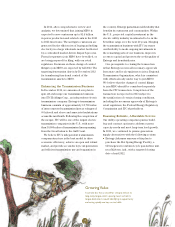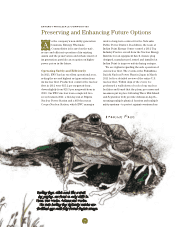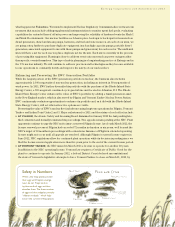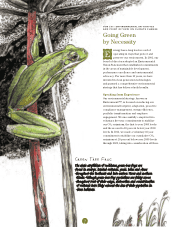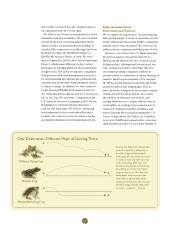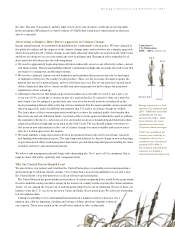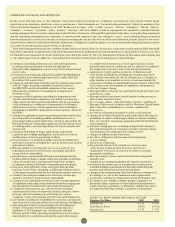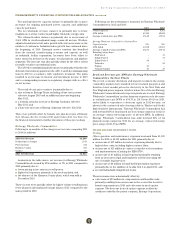Entergy 2011 Annual Report Download - page 27
Download and view the complete annual report
Please find page 27 of the 2011 Entergy annual report below. You can navigate through the pages in the report by either clicking on the pages listed below, or by using the keyword search tool below to find specific information within the annual report.
commitment periods. Our approach to emissions stabilization includes a variety of internal and external
projects paid for by an Environmental Initiatives Fund. For example, in past years we planted trees for
carbon sequestration on more than 6,000 acres of land in the lower Mississippi River valley, including
3,200 acres of Entergy-owned property. From 2000 through 2010, we spent $24 million on a combination
of internal and external emissions stabilization and offset projects, and we expect to spend an additional
$10 million through 2020.
In 2011, we announced two purchases of greenhouse gas reduction credits from Seneca Meadows, Inc.,
which owns and operates the largest non-hazardous solid waste facility in New York. SMI captures methane,
a potent greenhouse gas with a global warming potential 21 times greater than CO2, from decomposing
waste in a collection system and sends it to a landfill gas-to-energy facility. Entergy’s purchases represent
the equivalent of removing roughly 172,000 metric tons of CO2 from the atmosphere or taking more than
30,000 vehicles off the road for one year. The greenhouse gas credits were registered through Winrock
International’s nonprofit American Carbon Registry, a voluntary offset program with strong environmental
integrity standards.
Following a 2010 study, Entergy awarded a $250,000 grant to America’s WETLAND Foundation to
help build public support for policies to protect the Gulf Coast region against a changing environment.
The effort builds on the recommendations of “Building a Resilient Energy Gulf Coast,” a study Entergy
co-sponsored with America’s WETLAND Foundation, which identified a range of adaptation measures
to protect Gulf Coast communities from economic losses due to rising sea levels, subsidence and
population growth.
Entergy also funded the development of the world’s first methodology to establish carbon offsets
for deltaic wetlands restoration. Since 2009, Entergy awarded a total of $150,000 to Tierra Resources
for development of this new methodology, which was reviewed and approved internally by the
American Carbon Registry. Under the methodology, carbon credits created by restoring wetlands can be
registered and sold to help finance additional wetland restoration. Coastal Louisiana suffers one of the
fastest rates of wetland loss in the world and restoration costs are estimated in the tens to hundreds
of billions of dollars. This new methodology currently is undergoing a public comment period and
scientific peer review, with anticipated final approval in May 2012.
We support technologies that foster environmental sustainability while providing affordable,
reliable and clean power today and in the future. In 2011, Entergy donated electric vehicle charging
stations for installation at public universities and colleges. Students, faculty and staff who own electric
vehicles can now charge them at no cost while university researchers and Entergy collect usage data
Frogs’ feet vary dramatically
depending on their habitat.
Aquatic frogs have long, strong
legs with webbed back feet;
burrowing frogs have shorter
legs; and tree frogs have toe
pads that act like suction cups.
These adaptations enable frogs
to navigate effectively in many
different landscapes.
Aquatic Frog Burrowing Frog Tree Frog
Putting the Right Foot Forward
Entergy Corporation and Subsidiaries 2011
25





